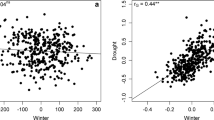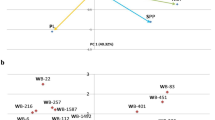Abstract
The analysis of multiples traits has been largely employed in animal and forestry crop breeding; however, in annual crops such as common bean this approach is practically lacking. This study examined the selective accuracy and estimates of genetic parameters in common bean using single- and multi-trait analyses in several designs of genetic correlations and heritabilities by means of simulated- and real-traits. We also compared the efficiency of the Bayesian and REML methods as regarding its selective accuracy and estimates of genetic parameters. In real data experiments, 100 endogamic families of common bean were assessed for grain yield (GY) and grain type (GT) in three environments using a 10 × 10 triple lattice design. Single- and multi-trait analyses were applied for these traits using REML-based BLUP analysis and Bayesian methods. In simulated experiments, traits corresponding to GY and yield components in common bean were simulated under several levels of genetic correlations and evaluated under different levels of heritability in order to verify in which genetic/experimental design it is advantageous to apply single- or multi-trait analyses. The results obtained in this study indicated that GY and GT present low genetic correlation and, therefore, multi-trait analysis may be unjustifiable for these traits. The Bayesian and REML multi-trait analyses were equivalent in point and interval estimates of genetic parameters and predictive accuracy, both for the field and simulated experiments. In addition, it was found that multi-trait analysis is justified in situations where the traits present low/moderate heritability and medium/high genetic correlations among them. It also was found that GY in common bean may be outstandingly favored in accuracy when evaluated jointly with its components. Thus, one can conclude that the simultaneous analysis of GY and yield components in common bean may provide superior gains accuracy and selection efficiency, being the response to selection better obtained by use of the multi-trait heritability.




Similar content being viewed by others
References
Bauer AM, Léon J (2008) Multiple-trait breeding values for parental selection in self-pollinating crops. Theor Appl Genet 116:235–242
Beaumont MA, Rannala B (2004) The Bayesian revolution in genetics. Nat Rev Genet 5:251–261
Brooks S, Gelman A (1998) General methods for monitoring convergence of iterative simulations. J Comput Graph Stat 7:434–455
Carlin BP, Louis TA (2000) Bayes and empirical Bayes methods for data analysis. Chapman & Hall, New York
Dempster AP, Laird NM, Rubin DF (1977) Maximum likelihood from incomplete data with EM algorithm. J R Stat Soc 39:1
Henderson CR, Quaas RL (1976) Multiple trait evaluation using relatives’ records. J Anim Sci 43:1188–1197
Kackar RN, Harville DA (1981) Unbiasedness of two-stage estimation and prediction procedures for mixed linear models. Commun Stat A 10:1249–1261
Klingenberg CP, Leamy LJ (2001) Quantitative genetics of geometric shape in the mouse mandible. Evolution 55:2342–2352
Marques Júnior OG (1997) Eficiência de experimentos com a cultura do feijão. Ph.D thesis, Federal University of Lavras
McLachlan G, Krishnan T (1997) The EM algorithm and extensions.Wiley series in probability and statistics. Wiley, New York
Meng XL, Rubin DB (1991) Using EM to obtain asymptotic variance-covariance matrices: the SEM algorithm. J Am Stat Assoc 86:899–909
Meyer K (1991) Estimating variances and covariances for multivariate animal models by restricted maximum likelihood. Genet Sel Evol 23:67–83
Meyer K, Thompson R (1986) Sequential estimation of genetic and phenotypic parameters in multitrait mixed model analysis. J Dairy Sci 69:2696–2703
Molina JC, Moda-Cirino V, Júnior NSF, Faria RT, Destro D (2001) Response of common bean cultivars and lines to water stress. Crop Breed Appl Biotechnol 1:363–372
Molungo LS, Tarimo AJP, Reuben SOWM, Lema DM, Makundi RH, Massaue AW (2006) Effect of seedbed type in yield and yield components of common bean commercial cultivar. J Agron 5:583–588
Mrode RA, Thompson R (2005) Linear models for the prediction of animal breeding values, 2nd edn. CABI, Oxfordshire
Piepho HP, Mohring J, Melchinger AE, Buchse A (2008) BLUP for phenotypic selection in plant breeding and variety testing. Euphytica 161:209–228
Raftery AL, Lewis S (1992) How many iterations in the Gibbs sampler? In: Bernardo JM, Berger JO, Dawid AP, Smith AFM (eds) Bayesian statistics 4. Oxford University Press, Oxford
Ramalho MAP, Santos EM, Zimmermann MO (1993) Genética quantitativa em plantas autógamas: aplicações ao melhoramento do feijoeiro. Editora UFG, Goiânia
Salehi M, Tajick M, Ebadi AG (2008) The study of relationship between different traits in common bean with multivariate statistical methods. Am-Eurasian J Agric Environ Sci 3:806–809
Samaniego JF (2010) A comparison of the Bayesian and frequentist approaches to estimation. Springer, New York, 225 p
SAS Institute (2000) SAS/STAT user guide v 8.0. Cary
Smith AB, Cullis BR, Gilmour AR (2001) The analysis of crop variety evaluation data in Australia. Aust N Z J Stat 43:129–145
Sorensen DA, Wang CS, Jensen J, Gianola D (1994) Bayesian analysis of genetic change due to selection using Gibbs sampling. Genet Sel. Evol 26:333–360
Sorensen D, Gianola D (2002) Likelihood, Bayesian and MCMC methods in quantitative genetics. Springer, Berlin
Taran B, Michaels TE, Pauls KP (2002) Genetic mapping of agronomic traits in common bean. Crop Sci 42:544–556
Van Tassel CP, Casella G, Pollak EJ (1995) Effects of selection on estimates of variance components using Gibbs sampling and restricted maximum likelihood. J Dairy Sci 78:678–692
Viana JMS, Sobreira FM, de Rezende MDV, Faria VR (2010) Multi-trait BLUP in half-sib selection of annual crops. Plant Breed 129:599–604
Waldmann P, Ericsson T (2006) Comparison of REML and Gibbs sampling estimates of multi-trait genetic parameters in Scots pine. Theor Appl Genet 112:1441–1451
Xu S (2003) Advanced statistical methods for estimating genetic variances in plants. Plant Breed Rev 22:113–163
Acknowledgments
The authors thank the Fundação de Amparo à Pesquisa do Estado de Minas Gerais (FAPEMIG) for supporting this research.
Author information
Authors and Affiliations
Corresponding author
Rights and permissions
About this article
Cite this article
Balestre, M., Torga, P.P., Von Pinho, R.G. et al. Applications of multi-trait selection in common bean using real and simulated experiments. Euphytica 189, 225–238 (2013). https://doi.org/10.1007/s10681-012-0790-1
Received:
Accepted:
Published:
Issue Date:
DOI: https://doi.org/10.1007/s10681-012-0790-1




